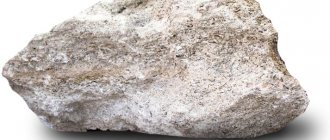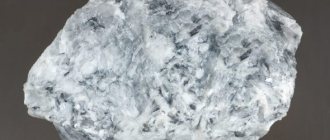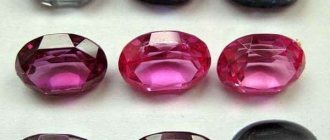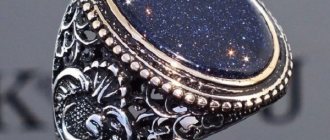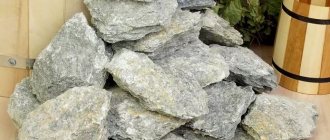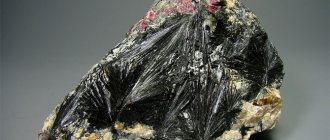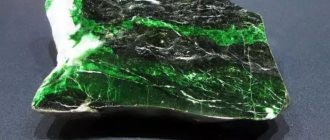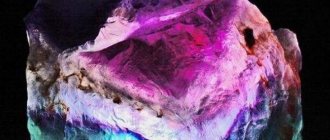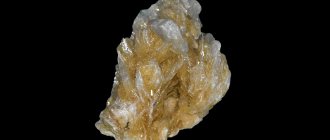Origin story
The ancient origin of the stone has been historically proven. The mineral magnesite was first discovered in Ancient Greece in a large mine located on the Magnesia (Magnesia) peninsula. The stone was named after this province (Magnesite).
The mineral interested workers due to its fire-resistant properties. It retained its shape and structure after firing at high temperatures.
It began to be used in the industrial sector. And jewelers were interested in the beautiful shine of the crystal.
In Russia, geologists discovered magnesite deposits at the Satka mine in 1894. Employees of the local plant also paid attention to the fire-resistant properties of the mineral and began to study the nucleation.
The stone began to be mined 5 years after its discovery. It was only in the mid-20th century that the mine began to be developed regularly.
Soon, Russian researchers discovered large deposits in the city of Berezovsky (Sverdlovsk region). In 1968, it began to be actively mined.
Gallery: magnesite stone (35 photos)
The magnesite mineral has several medicinal properties : it has a calming effect on the nervous system and improves mood. It is able to relieve tension and any fears, and bring a person out of a depressive state. The white mineral will help relieve eye fatigue if you look at it for a while without blinking. The stone has a good effect on children, it makes them obedient, cheerful and friendly. As a talisman, the gem is well suited for sailors, drivers and travelers; it will protect them from dangers that may occur along the way.
In astrology, magnesites are considered ideal stones for Geminis; they restrain their excitement and protect them from financial losses.
The mineral will help Capricorns and Libra get the maximum benefit from any situation, and it will also help them advance in their careers. But such a talisman is contraindicated for Aquarius and Aries, since the energy of the stone can make them vulnerable to outside influence.
Application of the mineral
The use of magnesite has found its place in almost all industries. In the field of manufacturing building materials, the mineral is used to produce magnesite slabs, which, due to the basic properties of the rock, are very popular and in great demand.
They are environmentally friendly, fireproof, durable, not affected by moisture, have good sound insulation and are easy to process. They are actively used in finishing houses, garages, interior walls of saunas and swimming pools, and are used in the production of doors and the construction of floor coverings. The mineral purifies water well, neutralizes and removes heavy metals from it, which is why it is widely used in the manufacture of water purification filters. In the metallurgical industry, magnesites are used in the production of refractory bricks and cement.
Erroneous legend
Some sources erroneously refer to the legend of the discovery of magnesite. In Greece, a shepherd named Magnes walked through the mountains, leaning on an iron cane. The walk was interrupted by an unusual stone, which attracted the tip of a stick and the nails in the sole of the boots.
The man took the stone home and told everyone about the unusual property of the stone.
We know this story from the words of the ancient Roman scientist Pliny, and later Leo Tolstoy also addressed it. But in fact, it is about another stone - magnetite.
Origin of magnesite
Magnesite is of hydrothermal and surface origin. Hydrothermal deposits are formed in two ways:
- By metasomatic replacement of calcium, limestones and dolomites with magnesium from hot magnesian solutions coming from the magma chamber. Deposits of this type always occur among dolomites and limestones; magnesite has a granular structure.
- Through the metamorphosing influence of carbon dioxide hydrotherms on olivine-containing ultrabasic igneous rocks (peridotites, dunites) (serpentinization process). The process of serpentinization of ultramafic igneous rocks is accompanied by the formation of magnesite. In this case, it is represented by amorphous varieties.
Magnesite of surface origin is formed in the following way. Serpentinized ultramafic igneous rocks on the Earth's surface are subject to chemical weathering processes. As a result, serpentinites decompose and form magnesium bicarbonate, which is carried by surface waters to the underlying horizons, where magnesite is deposited, forming veins, nests, and streaks in serpentinites.
Satellites . Among dolomites and limestones: dolomite, calcite, quartz, talc, chlorite, pyrite, chalcopyrite, limonite, malachite, galena, sphalerite, carbonaceous matter. Among serpentinites: serpentine, opal, olivine, talc, dolomite.
Varieties of mineral
Chemists distinguish five varieties of the mineral depending on the presence of impurities:
- nickel (hoshiite) – contains nickel;
- meysatite spar - proportions of iron and magnesium 30:70 or equivalent;
- ferruginous magnesite is a brown mineral with iron impurities;
- breunerite – ratio of iron and magnesium from 90:10 to 70:30;
- Helmagnesite is an amorphous mineral without a crystalline structure.
Magnesium oxide – Caustic magnesite
Attention, news!!! Due to the increase in production volumes and the need for rapid rotation of warehouse stocks, Stromex LLC is announcing an unprecedented price reduction for magnesite caustic powder PMK-83. The new price for magnesium oxide PMK-83 (grade 2) in the MKR is 10,000 rubles per ton!!!
Stromex LLC carries out regular supplies of caustic magnesite (caustic magnesite powder) of the PMK-75 brand (magnesium oxide content of at least 75%), PMK-83 brand (magnesium oxide content of at least 83%), as well as high-purity magnesium oxide - 98%, 99% (grade “C”).
Caustic magnesite (magnesium oxide, magnesium oxide, MgO) is widely used in the construction, chemical and metallurgical industries, including for the production of premixes and as a magnesia binder in the production of building materials, for the production of fire-resistant building materials and magnesia cement for the construction of industrial magnesia floors. In addition, caustic magnesite is used in agriculture as a mineral fertilizer and as a food additive in livestock farming.
In addition to supplies of caustic magnesite, it also sells synthetic magnesium oxide with a basic substance content of 98% and 99% (grade “Ch”, food additive magnesium oxide E530).
Magnesium oxide (caustic magnesite) is used both as a raw material component and as a finished product in the following areas of production:
- Construction: building materials and mixtures;
- Construction and metallurgy: materials for the production of refractory products;
- Metallurgical industry: magnesium fluxes;
- Oil and gas complex: materials for cement slurries;
- Chemical industry and energy: materials for water treatment and water softening;
- Agriculture and agro-industrial complex: premixes and feed additives for animals, fertilizer production;
- Medicine, pharmacology, cosmetology;
- Food industry;
- Raw materials for the production of magnesium metal.
One of the main uses of caustic magnesite (magnesium oxide) as a magnesium binder in the production of building materials is described in more detail in the article Magnesium building materials.
Main characteristics of magnesite caustic powder PMK-75 and PMK-83:
| № | Indicator name | Indicator value | |
| PMK-75 | PMK-83 | ||
| 1. | Appearance | fine powder, color from milky white to brownish brown | |
| 2. | Smell | without smell | |
| 3. | Mass fraction of MgO, %, not less | 75 | 83 |
| 4. | Mass fraction of CaO, %, no more | 4 | 4 |
| 5. | Mass fraction of Fe2O3+SiO2+Al2O3, %, no more | 15 | 12 |
| 6. | Change in mass upon ignition (P.P.P.), %, no more | 8 | 5 |
| 7. | Grain composition: passage through mesh No. 009, %, not less | 80 | |
| 8. | Setting time: beginning of setting, min., not earlier | 20 | |
| 9. | Setting time: end of setting, min., no later | 300 | |
| 10. | Packing | MKR (big bag) 800-1000 kg, poly bags 25 kg | |
Specialists will answer any of your questions related to the availability of the necessary products in the warehouse, terms of payment, shipment and delivery of products, and will also provide a current price list for products, taking into account a flexible system of discounts.
Stromex LLC ships chemical products on a self-pickup basis in batches of 1 ton (for packaging in MKR 500-1000 kg), or in batches of 0.1 ton (for packaging in 10-25 kg bags and for packaging in plastic cans (buckets) ) 1-10 kg) from our centralized warehouse in Novomoskovsk, Tula region. By agreement of the parties, it is possible to deliver the goods to the buyer’s warehouse by road and rail.
get the current price list for caustic magnesite (magnesium oxide) in the Prices section of our website.
You may also be interested in:
- bischofite (magnesium chloride, magnesium chloride)
- magnesium sulfate (magnesium sulfate 7-water)
- manganese sulfate (manganese sulfate 1-water)
- magnesium oxide 98% and 99% (grade “Ch”, food grade)
Return to the list of chemical products.
Main deposits
In the west of the Southern Urals, near Zlatoust, there is the largest Satka magnesite deposit. Here the mineral layers stretch for more than 20-25 km.
Throughout the array there are compounds of non-ferrous metals. Therefore, colored inclusions appear in an inconspicuous natural mineral.
Similar territories are located in China on the Liaodong Peninsula. Stone originates in rocks.
The stone is mined in Korea, Austria, Czechoslovakia, Korea, and the Far East. Geologists have discovered deposits in Australia, France and Brazil, the USA, and Italy.
Large strata deposits are common. Therefore, the stone has found application in industry.
Large layers originate during geological processes in the earth's crust at medium and shallow depths.
Magnesite colors
For jewelry, talismans and amulets, matte and transparent crystals of white, yellow, pink, green colors with a glass sheen are used.
Yellow stones are mined in deposits in Australia, pink ones with opal particles are mined in France, large stones of a beautiful brown hue are mined in Brazil.
Physical Features
The stone is brittle, with a dull or glassy luster. The crystals are granular, with an average hardness of 4 on the Mohs scale. The fracture is stepwise to conchoidal, density – 3.0 g/cm³.
There are transparent and translucent specimens.
Magnesite contains impurities of iron, manganese, and calcium. Natural minerals are white, gray, yellow, pink and brown. Often you come across stones with uneven zonal color.
The mineral is difficult to dissolve in water. But it disintegrates in heated acid and at temperatures above 580 degrees. This releases magnesium oxide.
When heated to 850 degrees, white caustic powder is formed. Treatment with temperatures above 1900 degrees transforms magnesite into the mineral periclase. It is added to ceramics and fire-resistant mixtures.
Physicochemical characteristics
Contains half magnesium
It has the chemical formula of magnesium carbonate. Magnesite varieties include fire-resistant magnesium oxide material with impurities. It can react to interaction with dilute acidic compounds, which is its distinctive property. Does not react with water.
Requires heating to 580° to decompose. During the reaction, magnesium oxide begins to release. In order to obtain a caustic mass, magnesite stone must be heated to 850°. In the process of firing mineral powder, caustic magnesite at temperatures up to 1900° is transformed into another mineral rock - periclase.
The mineral contains:
- magnesium oxide – up to 48%,
- carbon dioxide – up to 52%.
The composition and properties may vary due to the content of foreign impurities, among which iron, manganese and calcium are of great importance. Often contains inclusions of opal and magnesium silicates.
View
It is rarely found in crystalline form. In most cases, the crystals are ingrown, granular, completely dense or columnar.
Quite fragile, with stepwise fracture and perfect cleavage.
Magnesites are mainly formed from constituent elements that are too small in size and irregular in shape, resulting in an appearance reminiscent of porcelain.
Hardness is estimated at 4.0-4.5 points. Porcelain-like magnesite has a higher hardness - up to 7.0 points, which is ensured by the admixture of fine opal. The mineral is light, the density of magnesite is within 3 g/cm3
Color
The color shade is predominantly white or gray, rarely yellow or brown, close to black.
Use in folk medicine
Ancient healers used magnesite stone as a talisman against chronic diseases of internal organs. They believed that it prevents the development of pathologies and eliminates them in the early stages.
Allegedly, the stone increases the body’s immune strength and calms the nervous system. To do this, it is enough to sort the beads every day for 5-10 minutes. Nervous tension will subside, and a feeling of detachment and lightness will come.
In ancient China, white magnesite was used in eye treatment. It relieved redness and burning and improved vision. The stone is heated in your hands and placed on closed eyelids for 20 minutes.
The mineral helps eliminate discomfort. It is applied to the affected area for half an hour. It relieves pain from gout and arthritis.
Healing properties remove toxins and normalize the functioning of the sebaceous glands. Healers advise wearing magnesite beads or earrings for skin diseases.
Medicinal properties
Magnesium carbonate is included in a number of medications that help with exacerbations of diseases of the gastrointestinal tract: gastritis, stomach and duodenal ulcers, constipation.
Pure magnesium is obtained from the mineral, which is used to create vitamins containing this trace element.
Natural magnesite stones are used for massage for arthrosis, arthritis, radiculitis, and other diseases of the musculoskeletal system.
Athletes rub powdered magnesia (a mixture of magnesium carbonate and bicarbonate) on equipment in gymnastics and weightlifting to avoid injuries and falls.
Magic properties
Magnesite is known for its magical powers. Therefore, talismans are made from it.
It is considered a pimping stone. Jewelry with the mineral is given to girls who dream of meeting a loved one and finding a family. It is recommended to wear a pendant with a stone or simply put it in the pocket of a jacket or bag.
In Ancient Rus', after a wedding, jewelry made from this stone was given to mother-in-law and mother-in-law. They helped to establish family relationships.
The talisman brings inner harmony, tranquility and positive energy to the life of the owner. A person becomes more self-confident and liberated.
The energy of the stone imparts extrasensory abilities and teaches you to understand the language of animals. Astrologers consider the mineral a conductor to space. It helps to receive and recognize signals from the Universe.
The talisman is given to creative people. It is considered a symbol of travelers and people whose profession involves traveling. Magnesite protects them, protects them from troubles in a foreign land.
Practical significance
It is an ore of magnesium and its salts; used for the production of refractories and binders, in the chemical industry; used for the production of refractory bricks. When extracting magnesite, only limited use is made of mechanical (manual and using photocell and laser devices), and sometimes also flotation and electromagnetic enrichment.
At a temperature of 750-1000°C, chemically active powder, the so-called, is obtained from magnesite. caustic, magnesia, from which CO2 has not yet been completely removed. At 1500-2000°C, refractory magnesia is obtained, which consists mainly of periclase (MgO) crystals with a melting point of about 2800°C. At elevated temperatures (up to 3000°C), especially pure fused periclase is obtained in electric furnaces.
The most common product of magnesite processing, refractory magnesia, is used primarily in metallurgy. Caustic magnesia is used in chemical processing processes (weakly alkaline reagent, catalyst, etc.), as a fertilizer, for feeding livestock, in special cements, in the production of cellulose for gas purification, in the manufacture of filters, etc.
For the production of viscose, synthetic rubbers, paints (refractory filler), sugar and candy, in winemaking, glassmaking, ceramics (fluxes), electric heating rods, water and gas purification, in uranium processing, as an anti-corrosion additive to petroleum fuels, etc.
Magnesite is used quite widely in the jewelry industry. This stone can be painted, so a variety of jewelry is made from it. Magnesite is colored to resemble red coral, lapis lazuli, and turquoise.
Jewelry making
A mineral with a beautiful pattern and bright color is often used in jewelry. The stone is pre-polished and faceted.
Such specimens make beautiful beads, necklaces and bracelets. Magnesite is also inserted into earrings and rings.
Gold jewelry with magnesite is rare. Most often, jewelers use a silver frame.
The stone is porous, so it is easy to paint. Magnesites are found in blue, yellow, and red colors.
An energetically strong stone does not tolerate proximity to other minerals. It is not recommended to wear several jewelry at once if one of them contains magnesite.
White mineral beads cost from 340 rubles, bracelets – from 500 rubles.
Silver jewelry will cost more. The cost depends on the size of the stone. Ring – from 1.4 thousand rubles, bracelet – from 2.4 thousand rubles, earrings – from 2.3 thousand rubles.
Jewelry stores also sell men's cufflinks with stones - from 1.5 thousand rubles.
Areas of application of magnesite
Due to its properties, magnesite is widely used in industry and agriculture. It is actively used in the pulp industry, in the manufacture of water purification filters, and for gas purification. The stone effectively purifies water by neutralizing and precipitating heavy metals. It is used in the refractory and petrochemical industries, as well as in the production of fertilizers.
In the field of building materials, the mineral is used to make magnesite slabs, the popularity of which is rapidly growing due to the unique properties and characteristics of the stone. They are fireproof, environmentally friendly, durable, moisture resistant, have high heat and sound insulation, and are also easy to process.
Magnesite slabs are used for finishing the facades of houses, slopes, swimming pools, saunas and garages, arranging floors and making door panels. The natural structure and color of the slabs allow you to obtain an individual finish and natural design.
Magnesite is a popular ornamental stone and collectible mineral, but it is rarely used in jewelry, with the exception of bright yellow crystals found in Central Australia and specimens brought from Brazil. Colored magnesite can easily be confused with lapis lazuli, turquoise or red coral.
Household use
The main areas of application are the refractory, metallurgical and chemical industries.
Fire- and moisture-resistant stone is used in the production of bricks. Crushed magnesite is added to the building composition. The result is blocks that can withstand high temperatures - at least 300 degrees.
Magnesite precipitates heavy minerals. Therefore, it is added to filters for water purification.
Another area of application is pharmaceuticals. The stone is used to obtain magnesium.
It is also added to raw materials in the production of artificial marble.
The stone is used in pharmaceuticals to obtain magnesium.
Magnesite powder is used in the production of radio components, rubber, and abrasives. Anti-corrosion drugs and fertilizers are made from it.
Cement and slabs are made from the mineral to strengthen facades and walls. And also for whitening pools and saunas. Magnesite material is easy to bend and cut.
Industrial significance and applications of magnesite
Magnesite stone mined from deposits is usually used in processed form. As a result of firing natural stone, magnesite loses about 95% of the carbon dioxide it contains.
The result is a chemically active powder called caustic magnesite. As a result of mixing a concentrated solution of magnesium chloride and caustic magnesite, high-strength magnesia cement is obtained. It has a fairly wide scope of application.
Magnesite powder is used to produce refractory products.
The main distinguishing feature of such cements is that they provide rapid setting of solutions. The strength of solutions prepared with magnesium binder is 1000 kg/cm².
Magnesium carbonate provides the mortar mixture with a high degree of adhesion. Magnesium binder is most effective when using organic fillers. Of no small importance for the strength characteristics of the binder is the fineness of grinding.
The property of magnesium carbonate to withstand high temperatures allows it to be used for the production of electrical products and ceramics.
Products made from mortars with magnesium cement are characterized by a high degree of impact strength, heat resistance and have insulating properties.
In addition to refractories and cements, magnesite is used in the construction industry for the production of sheet building materials.
Magnesite slabs are an alternative to gypsum boards. Unlike gypsum, magnesite is not afraid of moisture, and it can be used in rooms with high air humidity.
Magnesia cement is used for the production of xylolite and fiberboard. These sheet building materials are slabs of organic material that are bonded with magnesium cement.
Proper care
The mineral is very fragile and requires careful handling. The stone can be scratched if it is hit hard and falls onto the asphalt.
Remove jewelry when cleaning and exercising.
Avoid mechanical impact on the stone. Store it in an individual velvet-lined box or velvet bag. Avoid proximity to gold items and durable stones.
The jewelry should not be cleaned with harsh chemicals or hard brushes. We recommend purchasing a jewelry cleaning spray. It is sold in jewelry stores.
The gentle composition will clean the stone and will not damage it.
If you can't buy the product, use warm soapy water to clean.

